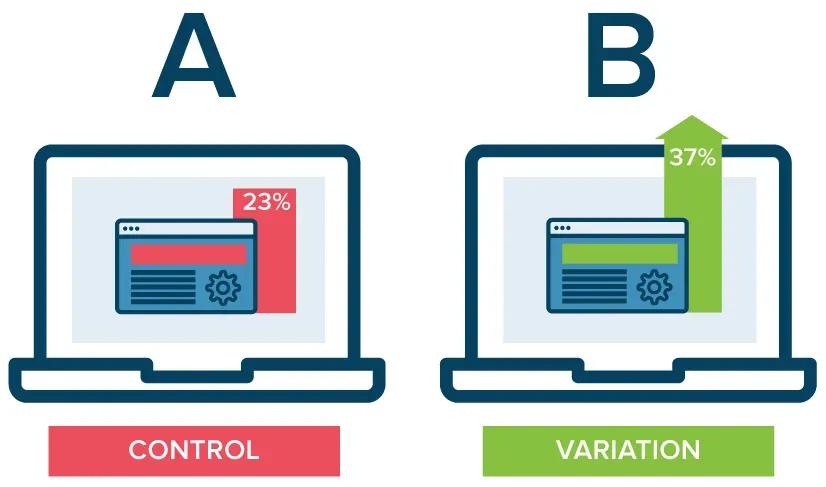User experience testing

The evaluation of your site on the first page is insufficient for the reputation and image of your brand. User experience of your website, when they click on a link, plays an important role in whether they want to stay on your website, to get what they are looking for. Their first experience also decides whether they will want to return to your site in the future or not. But how can I improve user interaction (UX) on their website? The answer is to test the experience.
Today we will discuss user experience testing (UX), as well as the following topics:
- Why is UX testing important for any website?
- What are the different UX testing methods for analyzing the current user experience?
- How to test UX?
- How do UX and CRO interact and how do they affect each other?
What is user experience testing (UX)?
User Experience Testing (UX) allows you to analyze your website so you can make changes to improve user interaction with your website. This will help you test the various elements and sections of your site that are can affect your users, and determine why and what to optimize on your site.
With UX testing, you can gather valuable information about users’ perceptions that they like and don’t like. they like that they tend to click, which navigation style is easier for them, which categorization of products and services allows users to easily find and explore things on their site.
Note that UX and UI are not the same thing. Here, the UI stands for User Interface and is a component User Experience (UX).
The difference between UX and UI
While UX refers to the entire user experience, from landing on your website and leaving your website, A UI is a visual layout of the elements that a user interacts with on a website page.
Why is UX testing important for any website?
You may not be impressed by our statement that UX is critical to all websites, but the following UX statistics are certainly will help you understand how important UX is to a website.
-
Full r, full r ,, showed, from, number, XNUMX Recent results from Forrester Research show that “well thought out frictionless UX design can potentially increase the conversion factor by 400% “. According to Designers Toptal, 88% of users are less likely to visit a website after a bad user experience.
-
According to Miklos Philips article - Know your user, mobile users are 5 times more likely to opt out task if the site is not optimized for mobile devices.
-
Research conducted by Forrester has shown that every $ 1 invested in UX brings $ 100 in return.
-
The same study conducted by Forrester also showed that if you use a UX design to meet sufficient the number of people to increase the content even by 5%, you will be able to get at least a 25% increase in profits. Capgemini said that 8 out of 10 customers are willing to pay more for a better experience.
-
Forbes reports that Jeff Bezos has invested 100 times more in customer experience than advertising in the first year Amazon works.
UX testing is no longer just a competitive advantage for business. Over the past few years, it has become a staple co-authored, and this will become more important as people are loaded with hundreds of options to choose from. If they don’t like it your website or they feel any friction, they can go to your competitors without any hesitation and delay.
Users quickly evaluate the website. One bad experience and you lose one potential customer. Although one client it may not seem bad to you, the loss of hundreds or thousands of customers due to a bad experience and your negligence in UX design, will definitely result in a loss in your income.
A smart business owner always pays attention to ensuring a smooth, frictionless and great experience and constant improving website design and performance. It’s like fixing a problem for its root cause, not treating the symptoms.
So, it is up to you what result you want and how to achieve it.
What are the different UX testing methods for analyzing the current user experience?
Now that you know what UX testing means and why it’s important for your website, it’s time to know the different methods. UX testing so you can also conduct UX testing for your website. Know that testing UX is not easy process.
First of all, wait a second and think about your website and goals. We know you obviously want to increase sales, but how can you do that? With just one click you are not going to fill your bank account with money.
Rather, you need to focus on what impresses your consumers to buy your products and services or what refuses consumers do not buy your goods and services. Finding out is what underlies UX testing.
To increase sales, you need to meet the needs of your customers and meet or exceed their expectations. Think about what they need to do to complete the ordering process.
- Go to your site
- Access to product information
- Check the call-to-action buttons
- Simple ordering process
- Trust symbols for payment
- Social proof, especially in modern conditions
The list can be very long, because what one audience needs is not necessary for it to be needed. and another. Therefore, one should not follow any methods or practice blindly.
UX Testing is not like other tests where there are certain parameters that you can test in a predetermined way. For UX-testing you ask questions or define a problem, form a hypothesis, set up an experiment with some real users, run tests and analyze what reviews, information, or issues users provide you with.
The following methods and information are just to get you started. However, you need to find out what is best suitable for you by testing your hypotheses with your own customer / user base.
Customer voice
It may come as a surprise to learn that only a few customers report their dissatisfaction. That means you’ll never know which worries your customers the most, as most of them do not share their bad experiences at all.
So find ways to listen to your customers’ experiences. You get insightful information through service reviews or products, reviews on third-party websites, emails, phone calls and feedback forms. Use all the feedback you receive from customers and add them to the database for analysis. You can even run quizzes or campaigns to get information about the user experience on your website.

Alternatively, you can create polls or surveys to ask people’s opinions directly. You can do this at their social media accounts, blogs, websites, or anywhere else. The main idea is to get opinions and feedback from customers. If they don’t reach you, you can contact them. Don’t just wait.
Sorting maps
While this may seem tedious, sorting cards is actually an interesting activity with which you can determine how you should classify the elements of your website. Until you first know the order, you will understand how the test is performed.
Prepare several cards with information on the back of the product description. Then ask participants or users to sort and classify content. You can use this method to categorize website components, such as pages support and information content, as well as products and services.

Best of all, you can sort maps both in person and in practice through the online tool. The ultimate goal - know how users prefer to categorize items or products.
Moderate user testing
During moderate user testing, there is a professional among the users who manages them. A professional moderates the experience testing, and this can be done in a room with participants or a moderator in a discussion room.
In both cases, the moderators answer the questions of the participants, direct them throughout the process, wherever there is needs, and share the goals you expect to achieve through the website.

This type of testing is useful when you need to explain to users / participants how a product or interface works. In the case of, when confusion cannot be resolved, there may be a problem with the user experience. The moderator can report later about what he noticed and collected during testing.
Non-upgraded user testing
It is believed that unmoderated user testing is more effective because the result and opinions of users are not affect the moderator. Thanks to this testing, you will be able to find out the true feelings of users when no one is around, to distract them.

But during this testing you also need to leave a little freedom to take into account the mistakes of users and unconcentrated behavior of the participant.
Therefore, to obtain more accurate information, it is good to conduct both moderated and unmodeled testing.
A / B testing
When it comes to which version gives the best results, A / B testing is the way to go. Compare the two versions of the website, pages, text, images, or buttons, gather results from your target audience, and find out which version is more successful.

We understand that you do not have time to do everything yourself. So, we suggest you use UX testing tools, because they allow access to high-quality data and well-developed analytics.
Here are some popular UX testing tools:
- Optimized
- Crazy Egg
- GTmetrix
- Photos of the browser
- Zurb
These tools help you view heat maps, view records, and analyze scroll maps to get in-depth information about user activities.
Here are some helpful tips for testing UX
- Try conducting tests with more users or participants, as this leads to more accurate ones results.
- Select test takers who belong to your target audience. For example, if you’re testing an app for a game, you don’t want people to be your test takers who aren’t interested in games. You can use for this available website traffic.
- One test is never enough to get an idea. You should continue to conduct tests as you progress your brand and business change and so do your customers.
- If you haven’t tested UX before, you won’t have to wait any longer. Once you get enough visitors or website members, start testing UX for your site.
How to test UX?
Learn the steps you need to take to test on UX.
- First, define your goals for what you want to know or achieve through UX testing. Although a lot businesses focus on sales, some focus on increasing downloads, while others may aim to get more subscriptions.
- When you know what you want to achieve, choose the UX Test Method that best suits your goals. There are several methods which you can choose, but you need to choose one that will help you achieve your goals and fit your budget.
- Make a clear plan that includes information about everything, including what you want to test as you test it, how you will run the test, who your participants will be, how to measure the results, what indicators are important for you and so on.
- Analyze your results; otherwise you will not know what causes friction and what works well.
How do UX and CRO interact and how do they affect each other?
To date, you have gained all the basic knowledge from the experience of using and testing UX. So here’s one of the most Controversial topics related to UX: how user interaction affects conversion rate optimization (CRO).
Instead of wasting time deciding who is part of each other, we will focus on how useful they are to each other.
Both the user experience (UX) and conversion rate optimization (CRO) conditions are similar in terms of achievement similar goals through analytics and feedback.
Instead of treating them as mutually exclusive processes, just remember that they complement each other and their The combination can greatly help in achieving different website and business goals.
UX testing provides a solid foundation for CRO.
Conducting random experiments is not as effective as conducting these experiments based on the results and UX test results. When website analysts test an idea based on UX research, it demonstrates much better results because this time you are not shooting in the dark. You have the facts, reviews and research on on which you can base your ORS experiments and hypotheses.
Thus, the introduction of UX-research in the CRO department allows you to say goodbye to random CRO experiments and help save time and money. Experiments driven by UX research are more effective, insightful, and valuable.
While CRO helps you know that something needs to change in your current experience, UX research helps you understand where to start.
UX Research helps to find the main problems and determine their priorities.
You can make some improvements by changing the color of the conversion button. But if with the design of your website there is some major problems, you will still face problems no matter how hard you focus on CRO.
To make a significant difference, you need to focus on improving your interaction with the website while concentrating on conversions. If you don’t, your chances of conversion will still be slim, no matter how much optimize the website. So, never leave usability tests on UX designers alone. CRO professionals should be open to using UX research to identify problems and prioritize them as well.
UX can help explore new possibilities.
It’s no secret that most healthcare professionals develop hypotheses or test settings with in mind desktop sites only. But UX designers don’t. They focus on different devices and deeper understand which types of changes are more effective on which device.
Since changing the desktop site doesn’t have to work the same way for the mobile version, it’s important to prepare strategy in consultation with UX designers.
UX designers can also help CRO professionals increase conversions for mobile-optimized sites devices.
On the other hand, UX designers can refer to tests and experiments conducted by CRO professionals to gather insights, which designers could have missed, and avoid conducting experiments already conducted by the CRO team.
Conclusion
A website is considered successful when it can attract potential customers for business. Anything less that takes away potential customers from your website to competitors can be detrimental. So, it is better that you do not pay attention not only on SEO, but also on UX, because it determines whether website visitors will become potential customers, and then with real customers or not. If you haven’t thought about improving user interaction yet, you should start working on it immediately.
